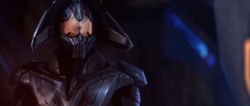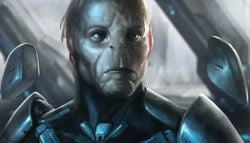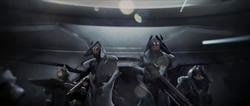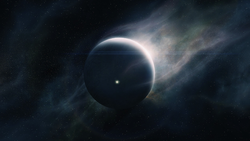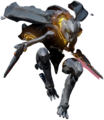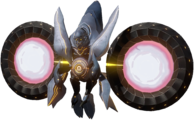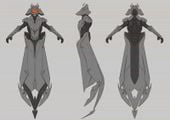Promethean: Difference between revisions
From Halopedia, the Halo wiki
No edit summary |
No edit summary |
||
| Line 27: | Line 27: | ||
[[File:Knight Battlewagon.jpg|thumb|250px|A [[Knight Battlewagon]], one of the types of Promethean inhabiting Requiem.]] | [[File:Knight Battlewagon.jpg|thumb|250px|A [[Knight Battlewagon]], one of the types of Promethean inhabiting Requiem.]] | ||
{{Quote|The human essences will go where all but [[Endurance-of-Will|one]] of my Prometheans have already gone. Their loyalty is now past question. They are our only hope against the parasite.|The Ur-Didact explaining his scheme to the [[Librarian]].<ref>'''Halo: Silentium''', ''page 294''</ref>}} | {{Quote|The human essences will go where all but [[Endurance-of-Will|one]] of my Prometheans have already gone. Their loyalty is now past question. They are our only hope against the parasite.|The Ur-Didact explaining his scheme to the [[Librarian]].<ref>'''Halo: Silentium''', ''page 294''</ref>}} | ||
The mechanical Prometheans are war machines created by the [[Ur-Didact]] after his descent into madness near the end of the [[Forerunner-Flood war]]. The Didact viewed these constructs as a novel and effective strategy to fight the Flood, without risk of biological infection. They encompass various classes of leader units known as [[Promethean Knight|Knights]], support drones known as [[Promethean Watcher|Watchers]], and small, pack-oriented [[Promethean Crawler|Crawlers]] designed to overwhelm the enemy from different directions. These Prometheans were encountered by UNSC forces and [[Covenant remnant|Covenant insurgents]] on Requiem in [[2557]]. | The mechanical Prometheans, sometimes referred to as the '''Prometheans of Requiem''',<ref>'''[[Halo 4: The Essential Visual Guide]]''', ''pages 50-57''</ref> are war machines created by the [[Ur-Didact]] after his descent into madness near the end of the [[Forerunner-Flood war]]. The Didact viewed these constructs as a novel and effective strategy to fight the Flood, without risk of biological infection. They encompass various classes of leader units known as [[Promethean Knight|Knights]], support drones known as [[Promethean Watcher|Watchers]], and small, pack-oriented [[Promethean Crawler|Crawlers]] designed to overwhelm the enemy from different directions. These Prometheans were encountered by UNSC forces and [[Covenant remnant|Covenant insurgents]] on Requiem in [[2557]]. | ||
The AI of each Promethean Knight is based on the neural pattern – essence – of an individual organic being, extracted and converted to machine data by the [[Composer]]. The original Knights were created from the Promethean warriors still loyal enough to the Ur-Didact to willingly comply with his scheme. As the numbers of these constructs began to rapidly dwindle, the Didact composed [[Omega Halo]]'s transplanted [[human]] population and used their essences to create thousands of more Knights; he also saw this as a way to neutralize the humans whom he saw as a threat, and to further punish them for their [[Human-Forerunner War|past aggression]].<ref name="h4terminals"/> | The AI of each Promethean Knight is based on the neural pattern – essence – of an individual organic being, extracted and converted to machine data by the [[Composer]]. The original Knights were created from the Promethean warriors still loyal enough to the Ur-Didact to willingly comply with his scheme. As the numbers of these constructs began to rapidly dwindle, the Didact composed [[Omega Halo]]'s transplanted [[human]] population and used their essences to create thousands of more Knights; he also saw this as a way to neutralize the humans whom he saw as a threat, and to further punish them for their [[Human-Forerunner War|past aggression]].<ref name="h4terminals"/> | ||
| Line 33: | Line 33: | ||
Visually, unlike most Forerunner technology which is chiefly angular and geometric, these Promethean machines have a more curved, almost organic aesthetic. Various Promethean units, including Knights and Watchers, have distinct heads embedded in their mechanical carapaces, complete with stylized facial features; this feature was shared by the [[war sphinx]]es used by the original Prometheans. Correlating with their role as weapons designed to fight the Flood, the Promethean machines' arsenal of weapons was specifically tailored to disintegrate targets to prevent the Flood from repurposing any available biomass.<ref name="gi">'''GameInformer''', ''October 2012 edition'' (digital content)</ref> | Visually, unlike most Forerunner technology which is chiefly angular and geometric, these Promethean machines have a more curved, almost organic aesthetic. Various Promethean units, including Knights and Watchers, have distinct heads embedded in their mechanical carapaces, complete with stylized facial features; this feature was shared by the [[war sphinx]]es used by the original Prometheans. Correlating with their role as weapons designed to fight the Flood, the Promethean machines' arsenal of weapons was specifically tailored to disintegrate targets to prevent the Flood from repurposing any available biomass.<ref name="gi">'''GameInformer''', ''October 2012 edition'' (digital content)</ref> | ||
{{Prometheans}} | |||
==History== | ==History== | ||
[[File: | [[File:H4 - Warrior-Servants.jpg|thumb|250px|A squad of Prometheans storm a human capital ship.]] | ||
For thousands of years, the fortified shield world [[Requiem]] served as the main command center of the Prometheans.<ref name="h4terminals"/> Following the [[Human-Forerunner War]] and the discovery of the [[Flood]], the Prometheans, under the leadership of the Didact, stood in opposition to the radical faction of [[Builder]]s led by [[Master Builder]] [[Faber]]. The Builders proposed the construction of the [[Halo Array]] as the ultimate weapon against the Flood, should they return, while the Prometheans advocated a more conventional solution: numerous [[shield world]]s constructed in strategic locations, used as enormous refuges and fortresses. After several millennia, the Prometheans lost the political battle and were subsequently removed from the [[Ecumene Council]], with the Master Builder's allies rising to power in the Council instead. Disgraced, the Didact and some of the other highest-ranking Prometheans were allowed the dignified choice of exile in a Cryptum, while some of the lesser-ranked commanders were accorded more severe punishments.<ref>'''Halo: Cryptum''', ''page 238-239''</ref> Out of fear of Builder persecution and losing their prestige, many former Prometheans joined the Builder rate, enlisting in [[Builder Security]].<ref>'''Halo: Silentium''', ''page 49''</ref> | For thousands of years, the fortified shield world [[Requiem]] served as the main command center of the Prometheans.<ref name="h4terminals"/> Following the [[Human-Forerunner War]] and the discovery of the [[Flood]], the Prometheans, under the leadership of the Didact, stood in opposition to the radical faction of [[Builder]]s led by [[Master Builder]] [[Faber]]. The Builders proposed the construction of the [[Halo Array]] as the ultimate weapon against the Flood, should they return, while the Prometheans advocated a more conventional solution: numerous [[shield world]]s constructed in strategic locations, used as enormous refuges and fortresses. After several millennia, the Prometheans lost the political battle and were subsequently removed from the [[Ecumene Council]], with the Master Builder's allies rising to power in the Council instead. Disgraced, the Didact and some of the other highest-ranking Prometheans were allowed the dignified choice of exile in a Cryptum, while some of the lesser-ranked commanders were accorded more severe punishments.<ref>'''Halo: Cryptum''', ''page 238-239''</ref> Out of fear of Builder persecution and losing their prestige, many former Prometheans joined the Builder rate, enlisting in [[Builder Security]].<ref>'''Halo: Silentium''', ''page 49''</ref> | ||
After a thousand years of exile, the Didact was reawakened amidst the [[Forerunner-Flood war]]. Shortly after his revival, a radical shift occurred in the Council, and Faber lost his political power due to his crimes against the [[Mantle]]. Called upon to defend the ecumene against the onslaught of the Flood, the new Council elevated the Prometheans back to their former status. With the | After a thousand years of exile, the Didact was reawakened amidst the [[Forerunner-Flood war]]. Shortly after his revival, a radical shift occurred in the Council, and Faber lost his political power due to his crimes against the [[Mantle]]. Called upon to defend the ecumene against the onslaught of the Flood, the new Council elevated the Prometheans back to their former status. With the Didact believed to the dead, his imprinted double, known as the [[IsoDidact]], took up his place as the supreme commander of Forerunner military forces.<ref>'''Halo: Primordium''', ''page 336-339''</ref> | ||
[[File:Requiem.png|thumb|left|250px|Requiem, the primary fortress world of the Prometheans.]] | |||
Under the new Didact's leadership, the Prometheans would lead the ecumene's defenses against the Flood until the end of the conflict and the activation of the Halo Array. Near the end of the war, the Ur-Didact was revealed to be alive and was returned to the ecumene. Still adamant in his opposition of the Halo Array, the Ur-Didact used of the [[Composer]], converting his Promethean warriors as well as a number of humans into [[Promethean Knight|war machines]]. Viewing the Ur-Didact's conscription of humans a severe transgression, the [[Librarian]] imprisoned him on Requiem and sealed off the shield world. She also took control of the mechanical Promethean forces stationed on Requiem, tasking them with preventing outsiders from awakening the Didact.<ref name="h4terminals"/> | |||
In [[2557#July|July 2557]], over four and a half years after the end of the [[Human-Covenant War]], [[John-117]] and [[Cortana]], drifting aboard the wreckage of the {{UNSCShip|Forward Unto Dawn}}, came across Requiem. They and a [[Covenant remnant]] force were forcibly pulled into Requiem and crashed on the surface, and were soon after engaged by the Promethean constructs inhabiting the shield world. After John-117 accidentally awoke the Didact, the latter took control of the Prometheans. Bent on preventing humanity's ascendance to the Mantle in the Forerunners' place, the Didact went [[Human-Promethean War|to war]] with humanity, trying to use the Composer to neutralize his ancient enemies forever. The Prometheans and Covenant remnant aided in this plan, but with the help of the [[AI]] [[Cortana]], the Master Chief defeated the Didact and destroyed the Composer and his ship ''[[Mantle's Approach]]'' with a [[HAVOK tactical nuclear weapon]]. However, the Promethean constructs continued to oppose the UNSC forces when the {{UNSCShip|Infinity}} returned to Requiem in [[2558|February 2558]].<ref>'''Halo 4''', ''[[Spartan Ops]]''</ref> | In [[2557#July|July 2557]], over four and a half years after the end of the [[Human-Covenant War]], [[John-117]] and [[Cortana]], drifting aboard the wreckage of the {{UNSCShip|Forward Unto Dawn}}, came across Requiem. They and a [[Covenant remnant]] force were forcibly pulled into Requiem and crashed on the surface, and were soon after engaged by the Promethean constructs inhabiting the shield world. After John-117 accidentally awoke the Didact, the latter took control of the Prometheans. Bent on preventing humanity's ascendance to the Mantle in the Forerunners' place, the Didact went [[Human-Promethean War|to war]] with humanity, trying to use the Composer to neutralize his ancient enemies forever. The Prometheans and Covenant remnant aided in this plan, but with the help of the [[AI]] [[Cortana]], the Master Chief defeated the Didact and destroyed the Composer and his ship ''[[Mantle's Approach]]'' with a [[HAVOK tactical nuclear weapon]]. However, the Promethean constructs continued to oppose the UNSC forces when the {{UNSCShip|Infinity}} returned to Requiem in [[2558|February 2558]].<ref>'''Halo 4''', ''[[Spartan Ops]]''</ref> | ||
{{Clear}} | |||
==Trivia== | ==Trivia== | ||
*Prometheans are color-coded based on the individual in command of them at the time; blue is used to represent the [[Librarian]], while the [[Didact]] is represented by orange.<ref name="h4terminals"/> Prometheans with blue lights only appear in the level ''[[Forerunner (level)|Forerunner]]'', until the Didact takes control of them in the final cutscene. Despite this, there is no in-game difference between the way the orange or blue Prometheans behave. | *The Prometheans of Requiem are color-coded based on the individual in command of them at the time; blue is used to represent the [[Librarian]], while the [[Didact]] is represented by orange.<ref name="h4terminals"/> Prometheans with blue lights only appear in the level ''[[Forerunner (level)|Forerunner]]'', until the Didact takes control of them in the final cutscene. Despite this, there is no in-game difference between the way the orange or blue Prometheans behave. | ||
*The name "Promethean" was probably inspired by the Titan [[Wikipedia:Prometheus|Prometheus]] in [[List of Greek mythology references in Halo|Greek mythology]], who gave the gift of fire to mankind. However, there is no in-universe relation between the names, as the Forerunners predated the Greeks by well over 100,000 years. | *The name "Promethean" was probably inspired by the Titan [[Wikipedia:Prometheus|Prometheus]] in [[List of Greek mythology references in Halo|Greek mythology]], who gave the gift of fire to mankind. However, there is no in-universe relation between the names, as the Forerunners predated the Greeks by well over 100,000 years. | ||
*"Promethean" was one of the names [[Catherine Halsey|Doctor Halsey]] considered for the [[SPARTAN-II Program]].<ref>'''[[Dr. Halsey's personal journal]]'''</ref> | *"Promethean" was one of the names [[Catherine Halsey|Doctor Halsey]] considered for the [[SPARTAN-II Program]].<ref>'''[[Dr. Halsey's personal journal]]'''</ref> | ||
Revision as of 03:07, November 8, 2013
- "Oh, but what I would not give to have even a single company of Prometheans here right now... oh, they would most certainly restore order with their trademark lethality..."
- — 343 Guilty Spark musing to himself as his Installation is about to be destroyed.[1]
The Prometheans were the highest and most respected group of Warrior-Servants in the Forerunner ecumene.[2] During and after the Human-Forerunner War, they were led by the Didact. The Prometheans' main base of operations was the shield world known as Requiem.[3]
During the Forerunner-Flood war, the Prometheans were converted into digital intelligences, known as Knights, by the Forerunner machine known as the Composer.[4] These constructs, along with the Didact, survived the activation of the Halo Array, eventually awakening within Requiem and rising to oppose the UNSC in 2557.[5]
Background
Physically, Prometheans were the highest form a Warrior-Servant could mutate to, standing around two times the height of a Forerunner Manipular and weighing about four or five times a Manipular's mass.[6] They were heavily muscled, their hands capable of easily crushing a human.[7] Their mental capabilities were also very sophisticated; during battle, it was common for a Promethean commander to share sensory input with thousands of warriors under their command.[8]
Promethean warriors utilized an assortment of combat skins, ranging from various conventional battle armor designs to much larger models, including midsize fighting suits known as war sphinxes; more akin to vehicles than armor, they possessed enough firepower to destroy cities.[9] In large-scale engagements, individual Prometheans could control automated phalanxes of up to a million weapon-ships.[10]
The Prometheans were responsible for creating "Warrior Keeps" known as Cryptums, where an exiled warrior could live in suspended animation for thousands of years.
Known Prometheans
- The Ur-Didact
- The IsoDidact
- The Confirmer
- The Grammarian
- The Strategos
- The Examiner
- Bitterness-of-the-Vanquished
- Endurance-of-Will
Mechanical Prometheans
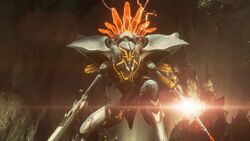
- "The human essences will go where all but one of my Prometheans have already gone. Their loyalty is now past question. They are our only hope against the parasite."
- — The Ur-Didact explaining his scheme to the Librarian.[11]
The mechanical Prometheans, sometimes referred to as the Prometheans of Requiem,[12] are war machines created by the Ur-Didact after his descent into madness near the end of the Forerunner-Flood war. The Didact viewed these constructs as a novel and effective strategy to fight the Flood, without risk of biological infection. They encompass various classes of leader units known as Knights, support drones known as Watchers, and small, pack-oriented Crawlers designed to overwhelm the enemy from different directions. These Prometheans were encountered by UNSC forces and Covenant insurgents on Requiem in 2557.
The AI of each Promethean Knight is based on the neural pattern – essence – of an individual organic being, extracted and converted to machine data by the Composer. The original Knights were created from the Promethean warriors still loyal enough to the Ur-Didact to willingly comply with his scheme. As the numbers of these constructs began to rapidly dwindle, the Didact composed Omega Halo's transplanted human population and used their essences to create thousands of more Knights; he also saw this as a way to neutralize the humans whom he saw as a threat, and to further punish them for their past aggression.[4]
Visually, unlike most Forerunner technology which is chiefly angular and geometric, these Promethean machines have a more curved, almost organic aesthetic. Various Promethean units, including Knights and Watchers, have distinct heads embedded in their mechanical carapaces, complete with stylized facial features; this feature was shared by the war sphinxes used by the original Prometheans. Correlating with their role as weapons designed to fight the Flood, the Promethean machines' arsenal of weapons was specifically tailored to disintegrate targets to prevent the Flood from repurposing any available biomass.[13]
| ||||||||||||||
History
For thousands of years, the fortified shield world Requiem served as the main command center of the Prometheans.[4] Following the Human-Forerunner War and the discovery of the Flood, the Prometheans, under the leadership of the Didact, stood in opposition to the radical faction of Builders led by Master Builder Faber. The Builders proposed the construction of the Halo Array as the ultimate weapon against the Flood, should they return, while the Prometheans advocated a more conventional solution: numerous shield worlds constructed in strategic locations, used as enormous refuges and fortresses. After several millennia, the Prometheans lost the political battle and were subsequently removed from the Ecumene Council, with the Master Builder's allies rising to power in the Council instead. Disgraced, the Didact and some of the other highest-ranking Prometheans were allowed the dignified choice of exile in a Cryptum, while some of the lesser-ranked commanders were accorded more severe punishments.[14] Out of fear of Builder persecution and losing their prestige, many former Prometheans joined the Builder rate, enlisting in Builder Security.[15]
After a thousand years of exile, the Didact was reawakened amidst the Forerunner-Flood war. Shortly after his revival, a radical shift occurred in the Council, and Faber lost his political power due to his crimes against the Mantle. Called upon to defend the ecumene against the onslaught of the Flood, the new Council elevated the Prometheans back to their former status. With the Didact believed to the dead, his imprinted double, known as the IsoDidact, took up his place as the supreme commander of Forerunner military forces.[16]
Under the new Didact's leadership, the Prometheans would lead the ecumene's defenses against the Flood until the end of the conflict and the activation of the Halo Array. Near the end of the war, the Ur-Didact was revealed to be alive and was returned to the ecumene. Still adamant in his opposition of the Halo Array, the Ur-Didact used of the Composer, converting his Promethean warriors as well as a number of humans into war machines. Viewing the Ur-Didact's conscription of humans a severe transgression, the Librarian imprisoned him on Requiem and sealed off the shield world. She also took control of the mechanical Promethean forces stationed on Requiem, tasking them with preventing outsiders from awakening the Didact.[4]
In July 2557, over four and a half years after the end of the Human-Covenant War, John-117 and Cortana, drifting aboard the wreckage of the UNSC Forward Unto Dawn, came across Requiem. They and a Covenant remnant force were forcibly pulled into Requiem and crashed on the surface, and were soon after engaged by the Promethean constructs inhabiting the shield world. After John-117 accidentally awoke the Didact, the latter took control of the Prometheans. Bent on preventing humanity's ascendance to the Mantle in the Forerunners' place, the Didact went to war with humanity, trying to use the Composer to neutralize his ancient enemies forever. The Prometheans and Covenant remnant aided in this plan, but with the help of the AI Cortana, the Master Chief defeated the Didact and destroyed the Composer and his ship Mantle's Approach with a HAVOK tactical nuclear weapon. However, the Promethean constructs continued to oppose the UNSC forces when the UNSC Infinity returned to Requiem in February 2558.[17]
Trivia
- The Prometheans of Requiem are color-coded based on the individual in command of them at the time; blue is used to represent the Librarian, while the Didact is represented by orange.[4] Prometheans with blue lights only appear in the level Forerunner, until the Didact takes control of them in the final cutscene. Despite this, there is no in-game difference between the way the orange or blue Prometheans behave.
- The name "Promethean" was probably inspired by the Titan Prometheus in Greek mythology, who gave the gift of fire to mankind. However, there is no in-universe relation between the names, as the Forerunners predated the Greeks by well over 100,000 years.
- "Promethean" was one of the names Doctor Halsey considered for the SPARTAN-II Program.[18]
Gallery
- Master Chief confronts Didact.png
The Ur-Didact against John-117, a SPARTAN-II.
List of appearances
- Halo: Cryptum (First appearance)
- Halo: Combat Evolved Anniversary
- Terminals (Mentioned only)
- Halo: Primordium
- Halo 4
- Halo: Silentium
- Halo: Rebirth (Mentioned only)
Sources
- ^ Halo: Combat Evolved Anniversary - Terminal 10
- ^ Halo: Cryptum, page 54
- ^ Halo Waypoint: Halo 4 Interactive Guide
- ^ a b c d e Halo 4, Terminals
- ^ Halo 4 Official Site, Characters
- ^ Halo: Cryptum, page 65
- ^ Halo: Cryptum, page 77
- ^ Halo: Cryptum, page 162
- ^ Halo: Cryptum, page 95
- ^ Halo: Cryptum, page 174
- ^ Halo: Silentium, page 294
- ^ Halo 4: The Essential Visual Guide, pages 50-57
- ^ GameInformer, October 2012 edition (digital content)
- ^ Halo: Cryptum, page 238-239
- ^ Halo: Silentium, page 49
- ^ Halo: Primordium, page 336-339
- ^ Halo 4, Spartan Ops
- ^ Dr. Halsey's personal journal
